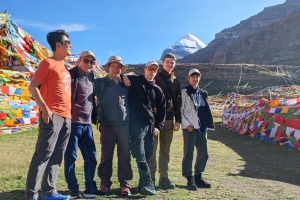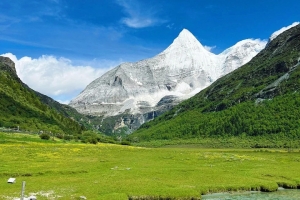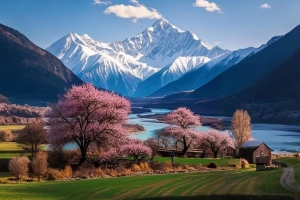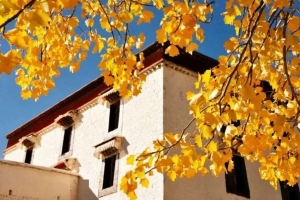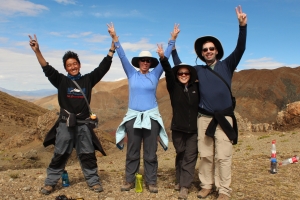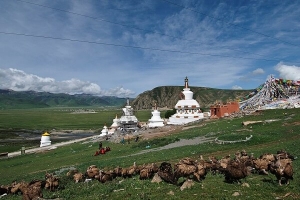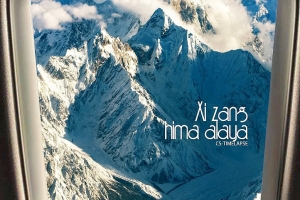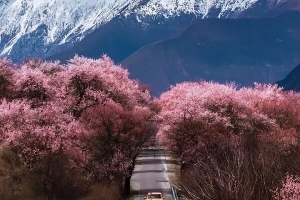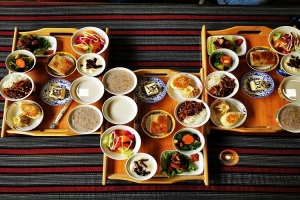Tibet is home to countless mysteries, and among them is the fascinating and enigmatic Guge Kingdom. Once a flourishing realm hidden within the arid landscapes of Zhada County in Tibet’s Ngari Prefecture, the Guge Kingdom played a crucial role in the region’s cultural, religious, and economic development.
Flourishing for over 700 years, this kingdom was a hub for Buddhist teachings, art, and trade. However, in the latter half of the 17th century, the Guge Kingdom mysteriously disappeared from history. Today, only its magnificent ruins remain, whispering tales of its glorious past. For travelers and history enthusiasts, visiting these ruins is like stepping into a lost civilization frozen in time.
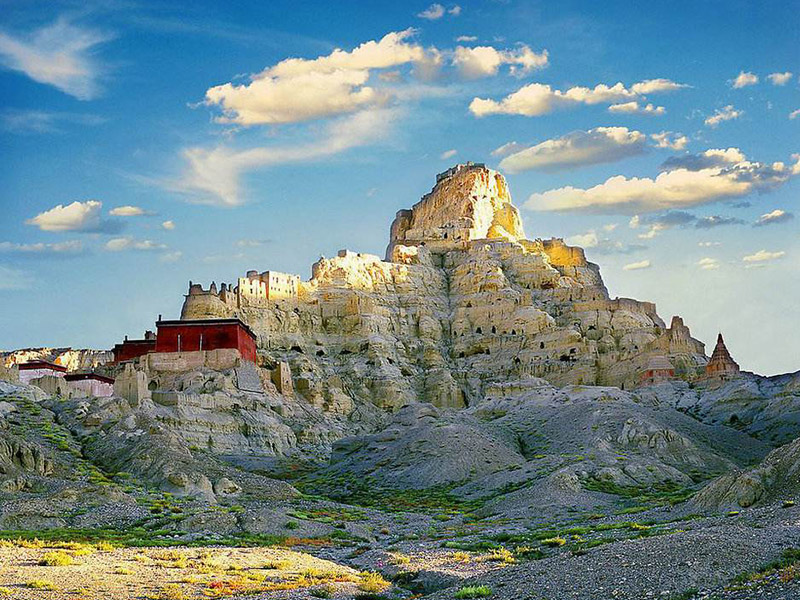
Ruins of Guge Kingdom
Origins and Flourishing Years of the Guge Kingdom
The Guge Kingdom was established around the 10th century AD after the collapse of the Tibetan Empire. It was founded by descendants of the royal family of the ancient Tubo dynasty, who sought refuge in the region after political upheaval in central Tibet. The kingdom quickly grew into a center for Buddhism, particularly influenced by Indian and Kashmiri traditions, and it played a vital role in the revival of Buddhism in Tibet.
The Guge rulers built impressive monasteries, palaces, and irrigation systems. The kingdom became a crucial trade link between Tibet, India, and Nepal, facilitating cultural exchanges and economic prosperity.
The Western Discovery of Guge
The first recorded encounter between Westerners and the Guge Kingdom occurred in 1624 when two Jesuit missionaries, António de Andrade and Manuel Marques, arrived in the region. They were astounded by the sophisticated irrigation channels and the grandeur of the kingdom. Welcomed by the then-reigning king, they were even permitted to teach Christianity within Guge’s monasteries.
However, not long after their arrival, tragedy struck. The kingdom’s ties with Christianity and its internal power struggles led to its downfall. In the latter part of the 17th century, the neighboring Ladakhi forces invaded Guge, ultimately leading to its demise. The kingdom was conquered, its people were either slaughtered or taken as prisoners, and its culture faded into history.
Exploring the Ruins of Guge
Today, the remains of the Guge Kingdom stand as a testament to its past glory. Despite centuries of erosion and abandonment, the ruins continue to captivate visitors with their architectural ingenuity and artistic heritage.
The Grand Palace: A Majestic Relic of the Past
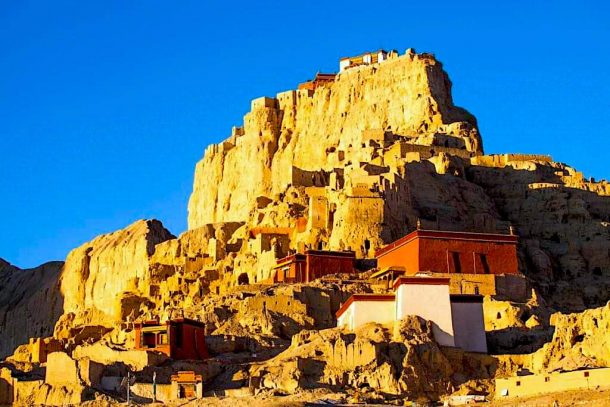
The Grand Palace
Perched on a rugged hilltop overlooking the Xiangquan River, the Grand Palace is the crown jewel of the Guge ruins. Covering an area of over 720,000 square meters, the palace is a labyrinth of interconnected rooms, tunnels, and passageways.
To date, archaeologists have discovered:
- 445 rooms
- 879 caves
- 58 pillboxes
- 28 Buddhist stupas
- 4 hidden tunnels
The strategic positioning of the palace and its defensive structures indicate that the Guge rulers prioritized security while maintaining a lavish lifestyle. Walking through these ruins, one can still see remnants of old city walls, watchtowers, and living quarters adorned with ancient artifacts like farming tools, pottery, and weapons.
The Frescoes: A Window into Guge’s Cultural Brilliance
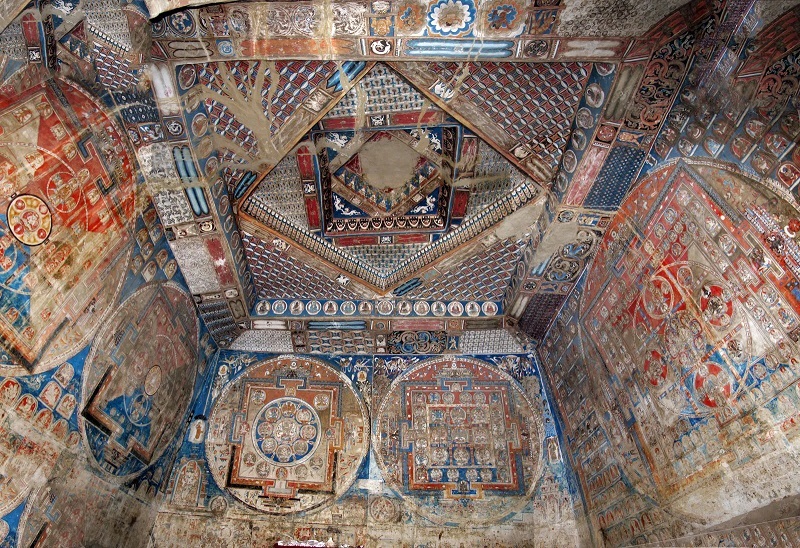
The Frescoes
Among the most captivating remnants of Guge are its exquisite frescoes. These murals, painted on the walls of temples and caves, depict Buddhist deities, religious ceremonies, and scenes of daily life in remarkable detail. The frescoes showcase a unique blend of Tibetan, Indian, and Kashmiri artistic influences, making them an invaluable treasure of Buddhist heritage.
Some of the most notable frescoes include:
- Depictions of Tara and Yamantaka: These prominent Buddhist figures are found in various temples, symbolizing wisdom and protection.
- The Mandala Chapel Murals: These intricate paintings illustrate the Buddhist cosmology and sacred teachings.
- Scenes of Royal Life: Some frescoes offer glimpses into the courtly life of Guge’s kings, with detailed representations of their clothing, feasts, and rituals.
While visitors can admire these frescoes in person, photography is strictly prohibited to preserve their delicate pigments.
The 28 Stupas: Silent Guardians of Guge’s Legacy
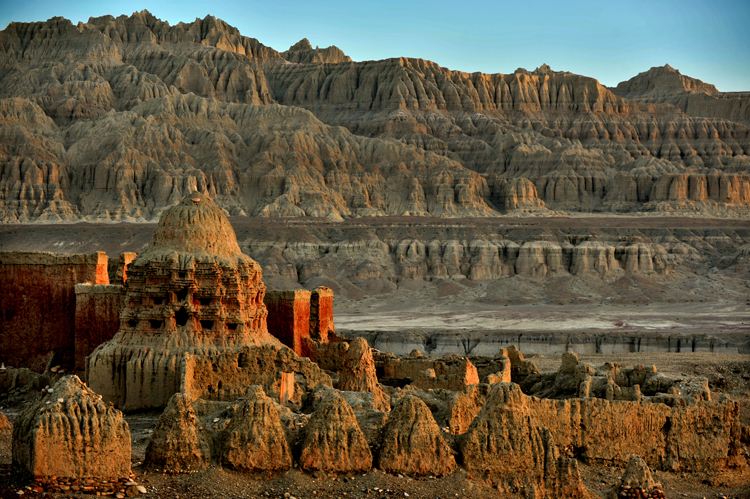
The 28 Stupas
Scattered across the Guge ruins are 28 stupas, standing as solemn reminders of the kingdom’s devotion to Buddhism. These structures, resembling pagodas, were built as spiritual monuments and possibly as burial sites for royalty and high-ranking monks. Their intricate carvings and symbolic designs reflect the advanced craftsmanship of Guge’s artisans.
Best Time to Visit the Guge Kingdom
Given its location in Tibet’s remote western region, the Guge Kingdom experiences harsh climatic conditions. The ideal time to visit is during late summer and autumn (July to October) when temperatures are moderate, and the skies are clear.
- Summer (June to August): Days are warm, but occasional rainfall can make travel difficult.
- Autumn (September to October): The best time to visit, with stable weather and stunning landscapes.
- Winter (November to March): Extremely cold, with sub-zero temperatures making travel challenging.
- Spring (April to May): The region starts warming up, but roads may still be rough from winter snowmelt.
Join Guge Kingdom Adventure Tours
15-Day Mount Kailash Group Tour: Ngari+Lake Manasarovar+Lhasa+Yamdrok Lake+E.B.C.+Shigatse
11-Day Tour Nyingchi+Lhasa+Yamdrok Lake+EBC+Qinghai-Tibet Railway
13-Day Tibet Tour on Flights and Soft Sleepers: Nyingchi+Lhasa+Everest+Yamdrok Lake+Shigatse+Namtso+Basomtso Lake
8-Day Tibet Classic Tour: Lhasa + Shigatse + Yamdrok Lake + Everest Base Camp + Namtso
If you need more info, please leave a message to let us know⇒ Contact Us
Travel Tips for Visiting the Guge Kingdom
- Altitude Preparation: Zhada County sits at an elevation of over 3,700 meters. Visitors should take time to acclimate in Lhasa or Shigatse before traveling to avoid altitude sickness.
- Accommodation: There are no hotels within the Guge ruins. The nearest lodging options are in Zhada County, where basic guesthouses and small hotels are available.
- Transport: The best way to reach the ruins is by booking a Guge Kingdom Tour with an experienced guide who can arrange transportation and permits.
- Permits: Foreign travelers need a Tibet Travel Permit and an Alien’s Travel Permit to visit the region. These can be obtained through a licensed Tibet tour operator.
- Clothing: Daytime temperatures can be warm, but nights are freezing. Layered clothing, a good jacket, and comfortable hiking shoes are essential.
- Food and Supplies: The area has limited food options, so bringing snacks and bottled water is advisable.
Photography and Ethical Travel Guidelines
Capturing the grandeur of Guge is a photographer’s dream, but there are cultural and ethical considerations to keep in mind:
- Best Photography Spots: The ruins at sunrise or sunset offer breathtaking lighting for landscape shots.
- Night Photography: The Guge Kingdom under a starry sky creates an otherworldly atmosphere, making it a perfect subject for astrophotography.
- Respect Local Customs: Photography inside temples and of frescoes is not allowed. Be mindful of local beliefs and avoid taking pictures of religious artifacts without permission.
- Camping Considerations: If you plan to camp near the ruins, ensure you follow Leave No Trace principles to preserve the site for future visitors.
Why You Should Visit the Guge Kingdom
The Guge Kingdom is a must-visit destination for travelers seeking adventure, history, and cultural immersion. It offers a rare opportunity to step back in time and witness the remnants of an ancient civilization that once thrived in the remote landscapes of Tibet.
Whether you’re drawn to its breathtaking ruins, intricate frescoes, or fascinating history, a journey to Guge is an unforgettable experience. Plan your trip carefully, respect the local culture, and embark on an adventure that will leave you with stories to tell for a lifetime.
For those interested in exploring the wonders of Guge, joining a Guge Kingdom Tour with an experienced travel agency like Journey2Tibet ensures a seamless and enriching journey through this lost kingdom of the Himalayas.

